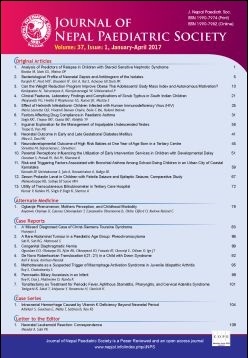Effect of Helminth Infestationin Children Infected with Human Immunodeficiency Virus (HIV)
DOI:
https://doi.org/10.3126/jnps.v37i1.16474Keywords:
Helminthiasis, HIV/AIDS, ImmunodeficiencyAbstract
Introduction: Infection by human immunodeficiency virus results in immune destruction, while studies among the Ethiopian immigrants in Israel showed that chronic helminthiasis induces immune dysregulation. With destruction of CD4+ cell and consequently progression to AIDS, the host may be more susceptible to invading organisms such as helminths. This study was aimed at determining the effect of immune state on the prevalence and intensity of helminth infection in HIV infected children in two hospitals in Abakaliki.
Material and Methods: It was a cross sectional study that involved consecutive recruitment of 84 confirmed HIV infected children attending the ART clinic. Stool analysis for subjects was done, using the Kato-Katz technique. Blood sample for estimation of CD4 cell count was carried outusing flow cytometer from the HIV positive subjects.
Results: A total of 84 subjects were recruited during the study period, majority were males (58.3%). Male to female ratio was 1.4:1. The age range of participants was 2-17 years, while mean age of subjects infected with helminthiasis was 6.10± 3.34 year. A significant number of subjects in advanced and severe immunological stages had helminthiasis (χ2 =12.49, p=0.001). There was however no significant relationship between intensity of helminthiasis and immunologic stages of subjects.
Conclusion: The study suggests that immunodeficiency state may increase the susceptibility of helminth infection in HIV infected children. Hence children with HIV/AIDS may benefit from routine testing and/or de-worming of helminth infection.
Downloads
Downloads
Published
How to Cite
Issue
Section
License
Authors who publish with this journal agree to the following terms:
Authors retain copyright and grant the journal right of first publication with the work simultaneously licensed under a Creative Commons Attribution License that allows others to share the work with an acknowledgement of the work's authorship and initial publication in this journal.
Authors are able to enter into separate, additional contractual arrangements for the non-exclusive distribution of the journal's published version of the work (e.g., post it to an institutional repository or publish it in a book), with an acknowledgement of its initial publication in this journal.
Authors are permitted and encouraged to post their work online (e.g., in institutional repositories or on their website) prior to and during the submission process, as it can lead to productive exchanges, as well as earlier and greater citation of published work (See The Effect of Open Access).



